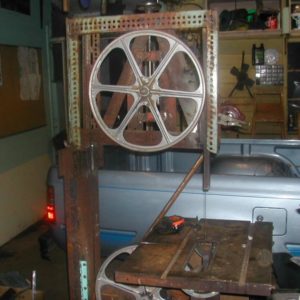Finishing off an 18″ bandsaw using a couple of wheels I found at a garage sale last summer.
Used an old 10″ table saw table for the table, rest is welded up frame from scrap metal laying about. Upper guide will be attached to 7/8″ square 4340 steel bar guide. Overall the thing weighs about 800# now, as the stand has a bunch of 8″ by 3/8″ steel channel.
Am to the final build where I need to make blade guides. First thought is for carter type ball bearing guides. Have seen 4 point ceramic guides touted in forums but have no direct experience.
What say you – experience, guide preferences, etc. I’ll be fabricating/machining the guides myself so any type is possible.
Edited 12/27/2008 9:28 am ET by junkhound




















Replies
My 14" Ridgid has the standard 3/8th square blocks, I replaced them with Corian, sorta like the cool blocks sold,I can then fully trap the blade, without fear of metal contact.
I never liked the wheel/bearing guides much, considering the added expense. Before the Corian I had used Ebony, and once Delrin. It all works.
Leave em long, and take out and sand a new face as they wear.
Spheramid Enterprises Architectural Woodworks
Repairs, Remodeling, Restorations
They kill Prophets, for Profits.
With the blocks it helps to wax the blade as well. Just keep a bar of parafin near the saw and rub on both sides as it spins. It tranfers to the blocks too.
I'm thinking the roller bearings are for more production work and resawing.
I've wanted to build a big bandsaw for a long time. Looks like fun!
Edited 12/27/2008 12:49 pm ET by popawheelie
The Lonnie Bird (Byrd?) bandsaw book has a great section on the different guide types.
He talks about the bottom/under-table guide and the upper/height-adjusting guide.
He touches on how you have a guide to counteract the push from the wood, as we well as the side to side movement.
He claims the heat that cool blocks claim to prevent is actually generated at the tooth and not from the friction on the side of the blade. It is interesting to see is "full enveloping wood blocks for thin blades. . .
After reading that, I'd love to see what "hybrid design" you'd come up with. . .
Hmmm.. I've never seen anything replace the thrust bearing.I think Art is wondering about the side guides. And they are not technically supposed to touch the blade, a dollar bill is the common feeler gage from what I have gathered over the yrs. That is because they are stock, steel blocks. They also will dull a blade in heartbeat when tracking gets out of whack.
The point about heat being from the teeth is somewhat true, but often in tight curves it is also from the back of the blade rubbing in the kerf sides and warming up. Mostly due to too wide a blade for the given radius.Spheramid Enterprises Architectural Woodworks
Repairs, Remodeling, Restorations
They kill Prophets, for Profits.
The book showed at least two forms of thrust bearings. One was arranged so the back of the blade cut across the face of the bearing - sort of like how you'd slice the letter O to get the letter C. The other had the back of the blade in a grove cut into the outer race race of the bearing - this was more like a belt across an idler pulley.
Oh yeah, I vaguely recall the latter type on a big resaw in my past..thanks for the reminder. Most smaller saws I've had or used have the former type.Spheramid Enterprises Architectural Woodworks
Repairs, Remodeling, Restorations
They kill Prophets, for Profits.
One old-fashioned type of guide is made of wood. Specifically, lignum vitae.
Its self lubricating, and can be milled to fit whatever shape you need.
OTOH, the Carter guides are sweet.
I just sliced and diced a frozen deer on mine yesterday, so mine is lubricated with her lard right now.
Welcome to the Taunton University of Knowledge FHB Campus at Breaktime. where ... Excellence is its own reward!
Phenolic resin embedded with graphite
http://www.leevalley.com/wood/page.aspx?c=2&p=30072&cat=1,41036
Free shipping this week but probably worth more than your homemade bandsaw :-)